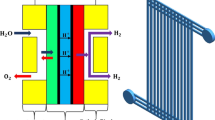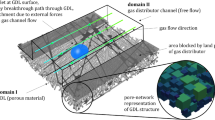Abstract
In this paper two-dimensional (2D), two-phase numerical model is proposed to investigate the effect of water velocity in the channel on the two-phase flow regime in polymer electrolyte membrane (PEM) electrolyzer porous transport layer (PTL). To simulate the movement of gas-liquid interface finite element method has been used. The model includes a porous media as PTL and a water channel. The water and air is considered as incompressible. The results showed different water velocities although causing different paths of two-phase flow in the PTL have little effect on the type of two-phase flow regimes in the porous media. On the other hand, different water velocities cause different two-phase flows in the channel. For effective removal of airflow in the PTL, the range of water velocities in which the two-phase flow regime in the channel is a bubbly flow is recommended. Therefore, the minimum velocity is necessary for the bubbly flow in the channel.












Similar content being viewed by others
References
Dedigama I, Angeli PA (2014) Current density mapping and optical flow visualisation of a polymer electrolyte membrane water electrolyser. J Power Sources 265:97–103
Hwang CM et al (2011) Influence of properties of gas diffusion layers on the performance of polymer electrolyte-based unitized reversible fuel cells. Int J Hydrog Energy 36(2):1740–1753
Ito H et al (2012) Experimental study on porous current collectors of PEM electrolyzers. Int J Hydrog Energy 37(9):7418–7428
Arbabi F, Kalantarian A, Abouatallah R, Wang R, Wallace J, Bazylak A (2013) Visualizing bubble flows in electrolyzer GDLs using microfluidic platforms. ECS Trans 58(1):907–918
Arbabi F, Kalantarian A, Abouatallah R, Wang R, Wallace JS, Bazylak A (2014) Feasibility study of using microfluidic platforms for visualizing bubble flows in electrolyzer gas diffusion layers. J Power Sources 258:142–149
Lee CH et al (2017) Influence of limiting throat and flow regime on oxygen bubble saturation of polymer electrolyte membrane electrolyzer porous transport layers. Int J Hydrog Energy 42(5):2724–2735
Djilali N (2007) Computational modelling of polymer electrolyte membrane (PEM) fuel cells: challenges and opportunities. Energy 32(4):269–280
Park JW, Jiao K, Li X (2010) Numerical investigations on liquid water removal from the porous gas diffusion layer by reactant flow. Appl Energy 87(7):2180–2186
Bazylak A, Berejnov V, Markicevic B, Sinton D, Djilali N (2008) Numerical and microfluidic pore networks: towards designs for directed water transport in GDLs. Electrochim Acta 53(26):7630–7637
Suresh PV, Jayanti S (2010) Effect of air flow on liquid water transport through a hydrophobic gas diffusion layer of a polymer electrolyte membrane fuel cell. Int J Hydrog Energy 35(13):6872–6886
Kuttanikkad SP, Prat M, Pauchet J (2011) Pore-network simulations of two-phase flow in a thin porous layer of mixed wettability: application to water transport in gas diffusion layers of proton exchange membrane fuel cells. J Power Sources 196(3):1145–1155
Arbabi F, Montazeri H, Abouatallah R, Wang R, Bazylak A (2016) Three-dimensional computational fluid dynamics modelling of oxygen bubble transport in polymer electrolyte membrane electrolyzer porous transport layers. J Electrochem Soc 163(11):F3062–F3069
Feng Q et al (2017) A review of proton exchange membrane water electrolysis on degradation mechanisms and mitigation strategies. J Power Sources 366:33–55
Kandlikar SG, Garofalo ML, Lu Z (2011) Water management in a PEMFC: water transport mechanism and material degradation in gas diffusion layers. Fuel Cells 11(6):814–823
Bai F, He X, Yang X, Zhou R, Wang C (2017) Three dimensional phase-field investigation of droplet formation in microfluidic flow focusing devices with experimental validation. Int J Multiphase Flow 93:130–141
Yue P, Feng JJ, Liu C, Shen J (2004) A diffuse-interface method for simulating two-phase flows of complex fluids. J Fluid Mech 515:293–317
Yue P, Zhou C, Feng JJ, Ollivier-Gooch CF, Hu HH (2006) Phase-field simulations of interfacial dynamics in viscoelastic fluids using finite elements with adaptive meshing. J Comput Phys 219(1):47–67
"COMSOL Multiphysics User's Guide," ed, 2012
Incropera FP, DeWitt DP (1996) Fundamentals of heat and mass transfer
Lenormand R, Touboul E, Zarcone C (1988) Numerical models and experiments on immiscible displacements in porous media. J Fluid Mech 189(1988):165–187
Zhang C, Oostrom M, Wietsma TW, Grate JW, Warner MG (2011) Influence of viscous and capillary forces on immiscible fluid displacement: pore-scale experimental study in a water-wet micromodel demonstrating viscous and capillary fingering. Energy Fuel 25(8):3493–3505
Chen L, Tian YS, Karayiannis TG (2006) The effect of tube diameter on vertical two-phase flow regimes in small tubes. Int J Heat Mass Transf 49(21–22):4220–4230
Coleman JW, Garimella S (1999) Characterization of two-phase flow patterns in small diameter round and rectangular tubes. Int J Heat Mass Transf 42(15):2869–2881
Cubaud T, Ho CM (2004) Transport of bubbles in square microchannels. Phys Fluids 16(12):4575–4585
Triplett KA, Ghiaasiaan SM, Abdel-Khalik SI, Sadowski DL (1999) Gas–liquid two-phase flow in microchannels part I: two-phase flow patterns. Int J Multiphase Flow 25(3):377–394
Hibiki KMT (1996) Some characteristics of air-water two-phase flow in small diameter vertical tube. Int J Multiphase Flow 22:703–712
Author information
Authors and Affiliations
Corresponding author
Additional information
Publisher’s Note
Springer Nature remains neutral with regard to jurisdictional claims in published maps and institutional affiliations.
Rights and permissions
About this article
Cite this article
Hoseini Larimi, S.Z., Ramiar, A., Esmaili, Q. et al. The effect of inlet velocity of water on the two-phase flow regime in the porous transport layer of polymer electrolyte membrane electrolyzer. Heat Mass Transfer 55, 1863–1870 (2019). https://doi.org/10.1007/s00231-018-2436-x
Received:
Accepted:
Published:
Issue Date:
DOI: https://doi.org/10.1007/s00231-018-2436-x




